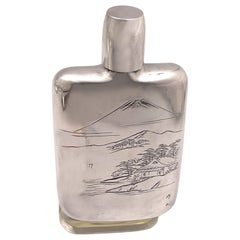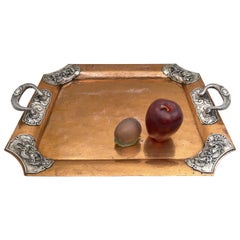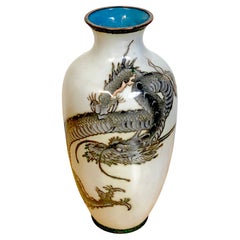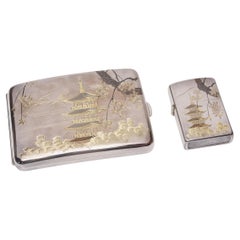Nathan Horowicz Antiques Asian Art and Furniture
to
3
3
3
1
3
3
2
1
3
3
3
3
3
3
Pair of Japanese Silver Teacups with Peacock and Floral Motifs
Located in New York, NY
Pair of Japanese silver teacups, beautifully adorned with engraved peacock and floral motifs. They measure 2 7/8'' in diameter at the top by 2'' in height, weigh 5.1 troy ounces (158...
Category
20th Century Japanese Metalwork
Materials
Silver, Sterling Silver
Japanese Sterling Silver Flask with Engraved Japanese Landscape with Shot Glass
Located in New York, NY
Japanese, 0.950 (higher purity than sterling) silver flask, finely engraved with a Japanese landscape on one side and hand-hammered on the other side, with an integrated shot glass, ...
Category
20th Century Japanese Metalwork
Materials
Silver, Sterling Silver
Japanese Mixed Metal Silver on Copper Tray with Dragon Motifs
Located in New York, NY
Japanese mixed metal copper and silver two-handled tray, from the late 19th or early 20th century, beautifully adorned with dragon motifs in relief on the rim and handles. It measure...
Category
Early 20th Century Japanese Metalwork
Materials
Silver, Copper
Related Items
Exquisite Japanese Wireless Cloisonné Dragon Motif Vase, Meiji / Taisho Period
Located in West Palm Beach, FL
Japanese Wireless Cloisonné Enamel Vase, likely from the Meiji period (1868–1912) or possibly the early Taisho period (1912–1926). The vase features a dynamic depiction of a Japanese...
Category
Early 20th Century Japanese Meiji Vases
Materials
Copper
Japanese Etched Silver Cigarette Case & Lighter
Located in Chicago, IL
This matching set of engraved silver cigarette accessories exemplifies Japanese refinement in all crafts. The set includes a rectangular cigarett...
Category
Mid-20th Century Japanese Metalwork
Materials
Silver
Japanese Silver Incense Burner, Akoda Koro, by Nomura, Meiji Period, Japan
Located in Austin, TX
A lovely and luxurious Japanese silver incense burner of lobed melon form, akoda koro, marked jungin and signed Nomura, Meiji Period, circa 1900, Japan.
The silver koro...
Category
Vintage 1910s Japanese Meiji Metalwork
Materials
Silver, Sterling Silver
Antique Asian Silver Plate Engraved Expanding Tea Trivet Decorative Stand
Located in Vancouver, British Columbia
Hand engraved expanding tea trivet with unique design and exuding finesse. May be used as a decorative screen, plaque or objet d'art, circa 1900-1910.
Category
Antique Early 1900s Asian Anglo-Japanese Metalwork
Materials
Silver Plate
Japanese Antique Copper Alloyr Tray / 1800-1900 / Gong / Wabi-Sabi Art
Located in Sammu-shi, Chiba
I bought a very attractive copper tray.
This is an item that was once used as a gong.
In other words, it was used as a percussion instrument.
It was also used in temples.
The materi...
Category
Antique 19th Century Japanese Edo Tableware
Materials
Copper
Pair of Antique Japanese Cloisonne Vases with Floral Decoration & Wooden Stands
Located in Hamilton, Ontario
This pair of vases are unsigned, but presumed to have originated from Japan and date to approximately 1920 and done in an Anglo-Japanese style. The vases are done in engraved brass w...
Category
Early 20th Century Japanese Anglo-Japanese Vases
Materials
Brass
A Pair Of Palatial Monumental Blue Chinese Cloisonne Enamel Vases With Peacocks
Located in New York, NY
Pair Of Palatial Monumental Blue Chinese Cloisonne Enamel Vases With Peacocks
Multicolored floral designs with an array of peacocks, flowers, a...
Category
20th Century Chinese Metalwork
Materials
Wood
Japanese Mixed Metal Vase Mounted as a Lamp Meiji Period
Located in Ottawa, Ontario
Japanese mixed metal vase
Mounted as a lamp
Meiji period
The bulbous-form body with long conical neck
decorated in high-relief copper w...
Category
Antique Late 19th Century Japanese Japonisme Table Lamps
Materials
Brass, Copper
Pair of Early Chinese Republic Era Cloisonne Vases with Stylized Floral Motif
Located in Hamilton, Ontario
This pair of antique cloisonne vases originate from China during the Early Republic period and done in the Chinese Export style. These vases are...
Category
Early 20th Century Chinese Chinese Export Vases
Materials
Brass
Japanese Meiji Period Sterling Silver 2 Handled Basket by Katsu Miyamoto
By Miyamoto Shoko 1
Located in Dallas, TX
PRESENTING a GORGEOUS, VERY HIGH QUALITY and EXTREMELY RARE piece of Japanese Meiji Period Sterling Silver 2 Handled Basket by Katsu Miyamoto.
EXQUISITE, EXCEPTIONAL, RARE & IMPORTANT!
This is definitely a Meiji Period piece due to the fact that it is marked with the sterling silver mark “jungin”.
The Meiji period was from 1868 to 1912 and in 1928 a law was introduced in Japan compelling the use of decimal marks for silver.
This pre-dates that decimalization law.
We are of the opinion that it is from circa 1900.
Miyamoto Shoko was founded in 1880 as the first silverware specialty shop. In 1899, Miyamoto Shoko’s silverwares were ordered by the family members of the Emperor of Japan, and to this day, they are making fine and graceful handicrafts with skillful craftsmen.
Loved by numerous customers since the Meiji era, Miyamoto Shoko’s products have also been given to Princess Mako and Princess Kako of Akishino, as well as Princess Aiko Toshinomiya, on their birthdays.
Katsu Miyamoto (宮本勝), in 1880, in order to increase the sales of tobacco and cigarettes to foreigners founded the Moyamoto Shoko company, which produced different silverwares in general and particularly silver cigarette cases. Miyamoto’s first name, Katsu (勝) in some sources is written as “Masaru”, since 勝 kanji can be pronounced in both ways.
This basket is of the HIGHEST QUALITY imaginable!
The top of the basket has the MOST GORGEOUS repousse work of flowers, probably lotus flowers, with leaves and foliage. It has an underlying chevron effect chasing, reflecting parquetry.
The 2 handles are cast in the form of bamboo handles.
The rim of the top likewise is cast as bamboo.
The base is equally stunning in a different way!
It is chased with a chevron effect, like parquetry flooring and the four feet simulate pieces of sliced bamboo with an interlinking gallery of support columns, likewise, simulating bamboo.
The QUALITY of WORKMANSHIP is OUTSTANDING!
The pieces weighs exactly 525 grams.
This piece takes my breath away!
This is one for the SERIOUS COLLECTOR of EXQUISITE AND RARE Japanese silver. You will not find another like it, for sale ANYWHERE ELSE IN THE WORLD …… I know as I have searched!
Provenance: Acquired from a Dallas Private Collector.
Dimensions: 9.6 inches wide, 7.6 inches deep and 2.75 inches tall ( 7.25 inches tall with handles up)
Condition: Very good. It looks like the base 4 legged gallery, has been repaired/re-attached to the base, but otherwise it is excellent and of Museum quality.
The Meiji period (明治時代 Meiji-jidai?), also known as the Meiji era, is a Japanese era which extended from October 23, 1868 through July 30, 1912.[1] This period represents the first half of the Empire of Japan during which Japanese society moved from being an isolated feudal society to its modern form. Fundamental changes affected its social structure, internal politics, economy, military, and foreign relations. The period corresponded with the reign of Emperor Meiji after 1868, and lasted until his death in 1912. It was succeeded by the Taishō period upon the accession of Emperor Taishō to the throne.
Solid silver pieces...
Category
Early 20th Century Japanese Meiji Metalwork
Materials
Sterling Silver
Japanese Nanban Tsuba with Dragons, Edo Period, early 19th century, Japan
Located in Austin, TX
A dramatic Japanese iron tsuba in the nanban (foreign) style, decorated with dragons and openwork and inlaid with silver and gold, Edo Period, early 19th century, Japan.
The fantast...
Category
Antique Early 19th Century Japanese Edo Metalwork
Materials
Gold, Silver, Iron
H 1.25 in W 4.5 in D 4.5 in
Japanese Iron Decorative Plate with Shishi Lion Motif
Located in Fukuoka, JP
An exquisitely crafted iron plate featuring a dynamic and finely detailed depiction of a Shishi (mythical lion-dog). The figure is portrayed with expressive movement and intricately ...
Category
Antique 19th Century Japanese Edo Metalwork
Materials
Iron




